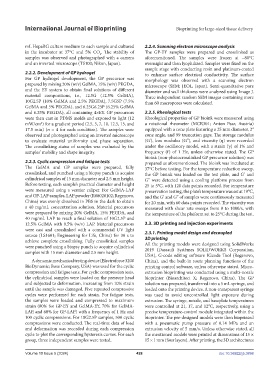Page 436 - IJB-10-5
P. 436
International Journal of Bioprinting Bioprinting for large-sized tissue delivery
mL HepaRG culture medium to each sample and cultured 2.2.4. Scanning electron microscope analysis
in the incubator at 37°C and 5% CO . The stability of The GP-EY samples were prepared and crosslinked as
2
samples was observed and photographed with a camera aforementioned. The samples were frozen at −80°C
and an inverted microscope (TS100; Nikon, Japan). overnight and then lyophilized. Samples were fixed on the
sample stage with conducting resin and platinum-coated
2.2.2. Development of GP hydrogel to enhance surface electrical conductivity. The surface
For GP hydrogel development, the GP precursor was morphology was observed with a scanning electron
prepared by mixing 20% (w/v) GelMA, 15% (w/v) PEGDA, microscope (SEM; JEOL, Japan). Semi-quantitative pore
and the EY system to obtain final solutions of different diameter and wall thickness were analyzed using Image J.
material compositions, i.e., 12.5G (12.5% GelMA), Three independent random SEM images containing more
10G2.5P (10% GelMA and 2.5% PEGDA), 7.5G5P (7.5% than 60 macropores were calculated.
GelMA and 5% PEGDA), and 6.25G6.25P (6.25% GelMA
and 6.25% PEGDA), all containing 4×EY. GP precursors 2.2.5. Rheological tests
were then cast in PDMS molds and exposed to light (12 Rheological properties of GP bioink were measured using
2
mW/cm ) for a gradient period (2.5, 5, 7, 10, 12.5, 15, and a rotational rheometer (MCR301; Anton Paar, Austria)
17.5 min) (n = 4 for each condition). The samples were equipped with a cone plate featuring a 25 mm diameter, 2°
observed and photographed using an inverted microscope cone angle, and 99 truncation gaps. The storage modulus
to evaluate material uniformity and phase separation. (G’), loss modulus (G”), and viscosity (η) were recorded
The crosslinking status of samples was evaluated by the under the oscillatory model, with a strain (γ) of 1% and
samples’ mobility and shape integrity. frequency (f) of 1 Hz, unless otherwise stated. The GP
bioink (non-photocrosslinked GP precursor solution) was
2.2.3. Cyclic compression and fatigue tests prepared as aforementioned. The bioink was incubated at
The GelMA and GP samples were prepared, fully 37°C before testing. For the temperature reduction sweep,
crosslinked, and punched using a biopsy punch to acquire the GP bioink was loaded on the test plate, and G’ and
cylindrical samples of 15 mm diameter and 2.5 mm height. G” were detected using a cooling platform process from
Before testing, each sample’s practical diameter and height 25 to 5°C, with 120 data points recorded. For temperature
were measured using a vernier caliper. For GelMA-LAP preservation testing, the plate’s temperature was set at 19°C,
and GP-LAP samples, LAP powder (R08020102; Regenovo, and the G’ and G” of samples were continuously measured
China) was evenly dissolved in PBS in the dark to obtain for 20 min, with 60 data points recorded. The viscosity was
a 40 mg/mL concentration solution. Material precursors measured with shear rate sweeps from 0 to 1000/s, with
were prepared by mixing 20% GelMA, 15% PEGDA, and the temperature of the platform set to 25°C during the test.
40 mg/mL LAP to reach a final solution of 10G2.5P and
12.5% GelMA with 0.5% (w/v) LAP. Material precursors 2.3. 3D printing and injection experiments
were cast and crosslinked with a commercial UV light
source (LS1601; Engineering for Life, China) for 30 s to 2.3.1. Printing model design and decoupled
achieve complete crosslinking. Fully crosslinked samples 3D printing
All the printing models were designed using SolidWorks
were punched using a biopsy punch to acquire cylindrical 2019 (Dassault Systèmes SOLIDWORKS Corporation,
samples with 15 mm diameter and 2.5 mm height.
USA), G-code editing software IGcode Tool (Regenovo,
A dynamic mechanical testing device (Electroforce 3200 China), and the built-in route planning functions of the
BioDynamic; Bose Company, USA) was used for the cyclic printing control software, unless otherwise stated. Micro-
compression and fatigue tests. For cyclic compression tests, extrusion bioprinting was conducted using a multi-nozzle
the cylindrical samples were loaded on the pressure head bioprinter (Bioarchitect X; Regenovo, China). The GP
and subjected to deformation, increasing from 10% strain solution was prepared, transferred into a 5 mL syringe, and
until the sample was damaged. Five repeated compressive loaded onto the printing device. A non-transparent syringe
cycles were performed for each strain. For fatigue tests, was used to avoid uncontrolled light exposure during
the samples were loaded and compressed to maximum extrusion. The syringe, nozzle, and baseplate temperatures
strain (80% for GP-EY and GelMA-EY, 70% for GelMA- were controlled at 21, 17, and 12°C, respectively, using a
LAP, and 60% for GP-LAP) with a frequency of 1 Hz and precise temperature-control module integrated within the
100 cyclic compressions. For 10G2.5P samples, 500 cyclic bioprinter. The pre-designed models were then bioprinted
compressions were conducted. The real-time data of load with a pneumatic pump pressure of 0.14 MPa and an
and deformation was recorded during each compression extrusion velocity of 5 mm/s. Unless otherwise stated, all
cycle to plot the corresponding hysteresis curves. For each the mentioned models were printed at dimensions of 15 ×
group, three independent samples were tested. 15 × 1 mm (four layers). After printing, the 3D architectures
Volume 10 Issue 5 (2024) 428 doi: 10.36922/ijb.3898

